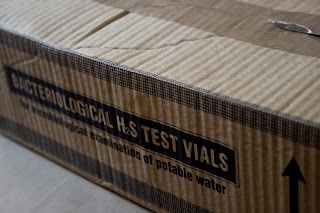I got permission to visit the village again, just to immerse myself and talk a little more to the children and community. The last visit was a little hurried and short for me to get many insights. Mr.Vishwanath suggested that I take a fluoride testing kit with me. He also gave me a set of H₂S strip test bottles. I got them home with me to see how I could use them. The manual itself might need some help, but the instructions and reason behind each step is very clearly given. This kit contained 2 glass cylinders, a sample collection bottle, 2 bottles of Zirconyl Alizarin reagent and some ph paper. My room almost looked like my school chemistry lab while I was setting this equipment up! I liked that :)
Before trying to use the kit, I read up a little on why one needs to test for fluoride in water.
‘Excessive presence of fluoride in ground water and their health effects have become a major geo-environmental issue in many parts of the world, including India. Fluorosis is an endemic disease caused by intake of F in quantities more than permissible limit for a prolonged time. Long term intake of F ( > 1.5 ppm) leads to three types of abnormalities; dental fluorosis (teeth), skeletal fluorosis (bones) and non skeletal manifestations. Latest reports indicate that less fluoride is always better in water. According to Indian standards of drinking water, desirable limit for fluoride is 1mg/l which may exceed to 1.5mg/l. Fluoride may be kept as low as possible.
Sources: Naturally by rocks and minerals, tobacco, tooth paste and powder, tea, preservatives and medicines.
Here is a link by the India Water Portal on Fluoride water testing kits and other quality testing kits
http://indiawaterportal.org/node/1123
I was given H₂S test bottles as well. These are used for testing the bacteriological content in water. It is a bottle in which the sample of water to be tested is put in. In the bottle, is a slide made of an inert plastic material coated with a nutrient. It is then shut and kept for a period of several hours or overnight. If, at the end of this period, the slide has acquired or changed colour it is an indication that the sample is contaminated. Tests for bacteriological contamination using such kits only indicate the presence or absence of contamination (also called a GO/NO GO result) and not its extent.
I tested the PH of the water I drink from the aqua-guard today! There was a PH strip test within the fluoride kit. It was around 7. The ph of normal portable water is around 6-8. I am hoping to show the children in the school how this works and make them test the water they use by themselves.









5 comments:
The new AP-7000-LTD probe is coming soon
Aquaread is proud to announce the latest addition to their range of water quality testing probes: the AP-7000-LTD. Specifically designed from the ground up for long term deployment, this new probe features extensive use of environmentally safe anti-fouling components and coatings in conjunction with a unique dual wiper mechanism.
Turbidity Meter
Could you please post the picture of the colour comparison chart too? Actually we have the same kit but lost the manual :(
Please post the pic, u'll have saved me!
thanks in advance,
yashvini
Great and you did water quality testing so well. This is so much useful in agriculture and industrials.
Good article
TDS in water testing
Nice post
TDS in water testing
Post a Comment